THE 2024 LA ART SHOW – By Dana Benson and Chris Cassone
The LA Modern and Contemporary Art show opened last Wednesday, February 14, 2024, at the LA Convention Center and ran for five days, closing this past Sunday.
It featured over one hundred and twenty galleries, museums, and art organizations from over twenty-three countries from all around the world, exhibiting twenty thousand works of art. It is one of America’s most comprehensive international contemporary art shows. Last year, there were thirty thousand visitors and thirty million in sales. The website says there were more visitors this time.
A fantastic array of paintings, sculptures, works on paper, installations, photography, design, video sculpture, and room-sized immersive installations were spread across two hundred thousand square feet of exhibition space.
We were overwhelmed by the volume and caliber of the art. Below are a few words about a few images we saw and some interviews. We apologize to the artists we missed or couldn’t mention in this article. The show was too big! It took the two of us several days to understand what was there. And then it was over.
Good art provokes, and lots of good art, which this show had, provoked a lot of thought. One reaction was it is a fine line between what ends up in the museum and what doesn’t.
One of the authors had worked as a consultant for major art museums nationwide for many years. He saw many installations at this show that were cunning, clever, thought-provoking, and evocative; he had seen similar pieces in museums through the years and wondered why some of the pieces he was looking at weren’t so honored.
This piece below, Keilchi Tanaami’s “Revolver 6/ Iyami & Nancy,” struck us because of its blatant derivation from the comics we grew up with.
Cultures collide when the West’s Nancy meets the East’s Iyami, an anime character with a massive overbite. One can’t help thinking that the Japanese artist is laughing at us, especially those who pay for this through the nose.
In music, if I use a sample of a hit song in my new song, I owe the original artist royalties. Somehow, that law is ignored in the art world. Including in that idea, the WW2 fighter amalgam (part Japanese Zero-part US Hellcat) seems to tie the two countries even closer. These first two works were bold with loud primary colors, demanding attention.
Chris Coleman is a Denver-based digital sculpture artist. His immersive film “Threaded Tracing” was one of the most dramatic pieces of visual art at the LA Art Show and one of the most fascinating experiences we have had in a long time. The film runs for seven minutes, with music by George Cicci.
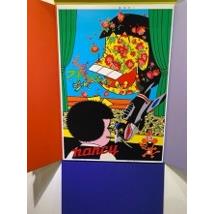
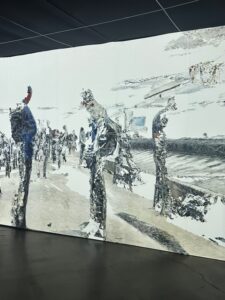
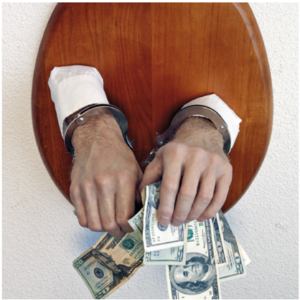
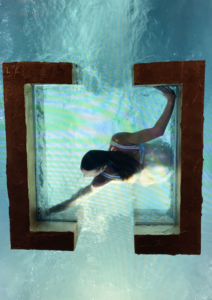
The immersive experience evokes the sense that this is what our world might look like if the universe’s fundamental laws, the forces of physics, stopped working and matter started slowly coming apart. It is a beautiful unwinding.
As you watch it, imagine you are in a vast dark room with a forty-foot projection screen. And no, you don’t need 3-D glasses. This is what a perfectly deconstructed society and its institutions might look like. Below is Coleman’s statement regarding creation.
“Threaded Tracing uses computer vision technology (LiDAR) to encode natural and man-made spaces into digital memory. Made during visits to forests and airports across the US, it plays with how we remember time and space vs. how computers try to represent and process it. As we feed more and more of our lives into AI systems, we must continue to ask what is lost in translation.”
Coleman was born in West Virginia and received his MFA from SUNY Buffalo in New York. His work includes sculptures, videos, creative coding, and interactive installations and has been exhibited across 25 countries. He is a Professor of Emergent Digital Practices at the University of Denver.
The Swiss artist MARCK presented a remarkable series of video sculptures; the one below, titled “Countercurrent,” featured a convincing illusion of a woman struggling to escape a structure as waves of water cascade over her.
It was one of the most arresting images in a show full of arresting images. MARCK is represented by the Licht Feld (German for Light Field) Gallery in Basel, Switzerland (see below).
Click here to see the “Countercurrent” sculpture in motion; stills below:
Another of MARCK’S sculptures, titled “Clockwork,” has a woman standing on a wooden platform, with water flowing around her, and every few minutes, a giant hammer slowly swings across the frame, and she ducks to avoid being hit.
Click here to hear Fredy Hadorn, artist and owner of Licht Feld Gallery in Basel, Switzerland, talk about
Freddy attended the School of Applied Arts in Basel. In 2001, he founded the Licht Feld art project in the Gundeldinger Field, a former industrial site in Basel, Switzerland, and it evolved into the gallery. Below is one of Freddy’s pieces.
Marco Olivier had a striking series of sculptures of faces, most over six feet high at the show. Each had a slightly different color, texture, and form, yet all were related. His pieces are a blend of resin and bronze.
Olivier is an internationally renowned sculptor from South Africa. In 2023, he won the Leonardo da Vinci Award at the Florence Biennale and the Best Artist Award at the Art Dubai Show. His pieces were warm, attractive, arresting, and meant for large spaces. See below: \
He is represented by the Dagaroella Fine Art Gallery of Cape Town, South Africa. Click here to hear gallery owner Corne Pretorious at the LA show talking about Olivier’s sculpture.
“Be Water” was an immersive film installation created by Artist Antuan, curated by Marisa Caichiolo, and sponsored by the AAL Museum in Santiago, Chile. Antuan is an environmental artist born in Cuba, lived in Chile, and is now based in Miami.
Click here to experience Antuan’s “Be Water”
Below is Antuan and his art:
He has exhibited in museums and art centers around the world, including the Museum of Contemporary Art, Mocca (Toronto), Cobra Museum (Amsterdam), Palacio de los Cristales (Spain), Central Fine Art Contemporary (Spain), The Frost Art Museum, (Miami, FL), Museum of Modern Art (Dominican Republic) and many others.
“Be Water” focuses on the interconnectedness of water and all life, especially human life. He reminds us that our bodies are over seventy percent water, and our brains are eighty percent. So, consciousness itself is tied to water, along with health.
As we corrupt the water, we corrupt ourselves. The fractal repeating patterns in his large metallic water drops symbolize the interconnectedness of every living organism with each and with water. Every waterdrop reflects the natural cycle of transformation and purification. As we wash our hands with soap, the dirtied water is drained back into the soil, filtered, and cleaned back into drinking water that rests underneath the ground until we tap it with wells and use it again.
As we grow increasingly distracted from our interconnectedness with water and nature, as we multitask in the “meta-verse”, Antuan’s art, including this installation at the LA show, increases in importance. We need experiences like his “immersion” to provoke us out of the “micro” online universes we are increasingly obsessed with. The artist reminds us of the expansiveness of nature and not to forget our essence.
In “Be Water,” the viewer enters a darkened room surrounded by repeating images of Antuan’s sculpted metal water drops in an AI film. It represents the cycle of water, life, and the truth that we are embedded in the universe.
As much as we are infatuated with our new silicon worlds, we remain of water; we are of water, and we can’t “be” without water. Antuan warns if we don’t remember to take care of the water, we won’t “be.” at all. We can live without the digital world. Bravo Antuan!
Below is a work titled Dodecahedron (Solar Black) by sculptor Anthony James. James is a London-born artist who is currently based in Los Angeles. James’ sculptures reflect the mathematical structure of the universe, with its universal patterns. His work reminded these reviewers of Jorge Luis Borges’s infinitely complex labyrinths and reminded us that all matter has a unifying structure.
This structure confirms the design and, to these reviewers, the evidence of design leads to the necessity of a designer. James has created some of the most beautiful matrices we have ever seen.
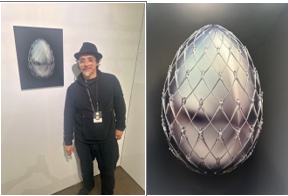
As it says on his website, “At the core of Anthony James’s artistry lies a philosophy deeply rooted in Plato’s Theory of Forms and sacred geometry. He believes his creations transcend geographical, cultural, and linguistic boundaries, speaking a universal language that resonates with individuals worldwide. His art taps into a primal connection to the fundamental principles of sacred geometry that weave through the fabric of the universe.”
Above is a photo of James at his solo exhibition titled “Morphic Fields” last year at Cal Poly Pomona (from the MMFA gallery website). Melissa Morgan Fine Art (MMFA) of Palm Desert, CA, represents James and many other blue chip and mid-career artists.
Dutch artist Nemo Jantzen, born in 1970 in The Haque, studied art, design, and photography at the RTO Art Academy in Rotterdam. Jantzen collects thousands of images, embeds them in resin spheres, and then organizes them on a canvas to create a mixed-media portrait. You enjoy the picture, but only as you move closer do you realize that it comprises many tiny sub-images. It is very cool! He exhibited “Ice” at the show (see images below). Check out a video of his art here.
As it says on his website, “The work requires and inspires viewers to constantly investigate their perspective through the interplay of walking up close and standing at a distance.”
“Part of Jantzen’s intent seems to be bringing awareness to viewers of how individual perception is influenced by mass media messaging,” “We sometimes get bombarded by so much information that we lose sight of the big picture.”
Nemo Jantzen, “Ice”, Mixed Medium, Signe Gallery
Below is a piece of pop art titled “Super T” representing a European reaction to former President Donald Trump. As Italian/French artist Nathalie Serero explains in this clip, Super T , Trump is puzzling to Europeans.
They do not trust his bombastic and mercurial personality. He says things that leaders are not supposed to say. He is one of the world’s most important and influential people. Yet, to them, he feels like a cartoon character fighting to save the American Dream, a dream they disdain.
Trump to them, according to Serero, is a cartoon character. “Why hadn’t the previous five American presidents asked Europe to pay what they had promised into NATO?” Trump bellows repeatedly. “Why should America pay for Europe’s defense?” he asks. “Fake news! Fake news!” he shouts, and the Europeans shake their heads.
Like Superman, Trump stands for truth, justice, and the American way, a way that seems crude, simplistic, and incomprehensible to Europeans and commonsense to some Americans. Shouldn’t Europe pay into NATO what the treaty says that they should? Why didn’t other American Presidents demand that they do?
Serero sees Trump as a larger-than-life personality with no counterpart on the continent. She attempts to capture some European attitudes toward Trump in “Super T”.
Check out Serero’s other pop art here: https://www.sereropopart.com/
Below is an intriguing sculpture titled “Blue” by Ardan Özmenoglu. According to her website, her works mainly consist of site-specific installations, paintings, and transparent glass sculptures that she creates using original screen-printing techniques on different material surfaces.
Özmenoğlu was born in 1979 and lives in Istanbul, Turkey. “Blue” is blue nail polish segments on glass sheets enclosed in a glass cube. The blue rings line up like the rings of a tree and form the image of a tree, and the glass cube rests on a tree trunk. It is a fun and attractive play on the idea of a tree.
Learn more about her work here: https://www.ardanozmenoglu.com/

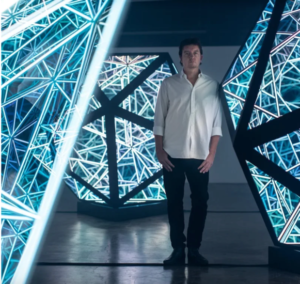
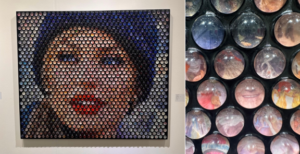
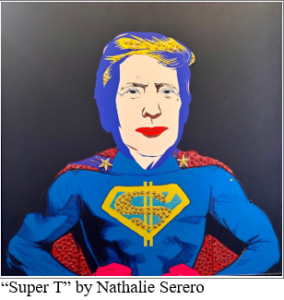
Standing next to Özmenoğlu’s piece is LA screenwriter Alex Amorelli, wearing a painted suit created by DAK and Christine, artists who volunteered to help set up the show.
In the third picture, you see DAK and Christine. DAK is wearing one of his “One of a Kind.” The clothing is individually painted and numbered you can wear it! How cool! I put in an order. If you are interested in learning more email DAK @ mailto:Reachdak@gmail.com
Weeda Hamden is a Lebanese painter who fled the civil war and wound up in Texas after spending time in Liberia. There is an irony there, given that Liberia was founded by freed American slaves seeking their freedom.
As Weeda explains in this clip, Weeda , after having her home destroyed by war and finding herself a stranger in a new land with few friends and family, she found solace in nature, in the forests and the land. Below is an example of her oil on canvas work.
The first image is of “Bare Trees.” The second is of painter Weeda Hamden and Salvatore Russo of the Effetto Art Foundation of Palmero, Italy. Effetto curates her work. Learn more here: https://www.effettoarte.net/about-us/?lang=en.
Below is an oil on canvas painted by Ukrainian-born, NY-based artist Denis Sarazhin titled “Lion Night.” The Arcadia Contemporary Gallery represents Denis. We didn’t have time to research Sarazhin, but his piece struck us as an interesting take on Cervantes Don Quixote. Learn more here:
mailto:http://sarazhin-denis.com
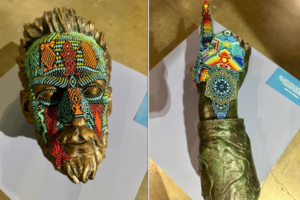
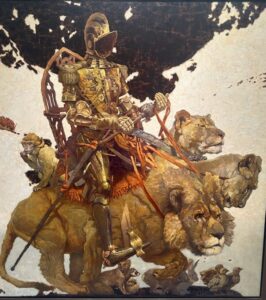
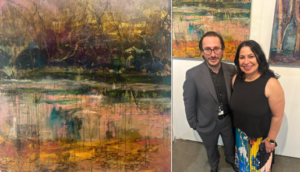
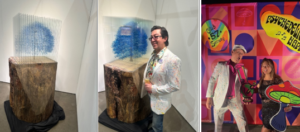
The Museum Contemporary Art of Bogota, Colombia, had an exciting exhibit that included complex large tapestries created by Carlos Castro Arias and curated by Gustavo Adolfo Ortiz Serrano.
Part of the exhibit featured the hand of a sculpture of Christopher Columbus that had been taken down from a public square. It was titled “Sticking Deep Inside.” The artist had embroidered beads from the native Colombian people, the Inga, on the hand, creating a striking image.
Also included was the head of a statue, a conquistador, which was embroidered. Presumably, part of the reason for including these pieces was to highlight the negative aspects of the Spanish Conquest of the New World.
It always strikes these reviewers as odd that the art and history of the conquest emphasizes the cruelty and injustice of the Spanish and seldom mention the cruelty and injustice of the human sacrifice culture that the Spanish met in some areas when they arrived, particularly in Montezuma’s Mexico, or the oppression that existed, with Montezuma’s Mexican tribe having conquered the surrounding tribes.
The Mexicans forced the tribes under their dominion to pay taxes, contribute men to the army, and deliver a quota of captives weekly to be sacrificed to the gods. And the Mexicans took their wives and daughters when they wanted them. Having said all of that, the idea of the native Columbian Inga culture surviving the conquest is inspirational.
The first image, “Artisanal Vandalism”, is unattributed.
It is the bronze face of Amazon conquistador Francisco de Orellana, who intervened with beads using symbols of the Inga culture of Colombia’s Putumayo. It is based on a work from the 1950s by the sculptor Luis Pinto Maldonado. (Language from the exhibit.)
The second image, “Sticking Deep Inside,” is unattributed.
Christopher Columbus statue fragment. Bronze and beads featuring symbols from the Inga culture of Colombia. The hand mold was taken from a statue that was removed from a plaza in Bogata in 2021. (Language from the exhibit.)
Below is “Kara”, 2021, by Yulia Shtern, an unusual take on a cobra.
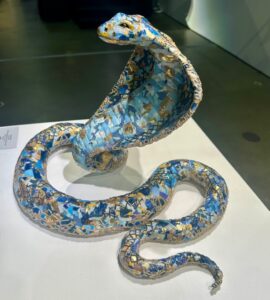
http://www.1202contemporary.com/
Take this below, Feiran Wang’s “Mutated Chicken”

It screams Marcel Duchamp’s “Fountain.” But not one of the young art assistants at the show knew about Duchamp’s famed urinal he hung on the art show wall in 1917. That action became the start of the modern art movement. He was so offensive that the new movement of Dada summarily kicked him out.
But that’s where we are now in the art world (some would argue in music, literature, and politics, too.) Anything goes, and to hell with our roots.
What we noticed very early on at the Art Show was that there were so many works, all screaming for attention. Some of the art made us stop, ponder, and interact, for had a lasting effect on our souls.
Once again, as we said at the beginning, we apologize to all the great artists and great art that we couldn’t include in this article. To all exhibitors, thank you for making the effort to come to Los Angeles and enrich our lives with your work.
Below are parting shots of your reviewers. Chris Cassone is “eyeing the show” and Dana Benson is “eyeing himself” in one of Marco Olivier’s bronze and resin sculpted mirrors.
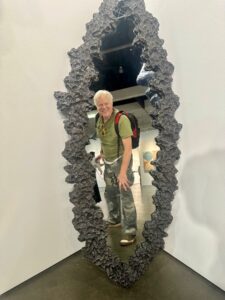
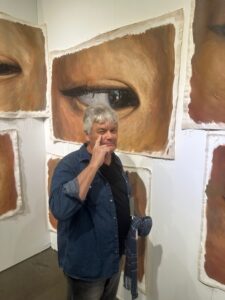
To ensure you don’t miss getting “eyes on this show” next year, consider adding yourself to the mailing list here to get a reminder notice.
Chris Cassone splits his time between writing his coffee table best seller, “STOMP BOX ART,” and the Greek Theater Advisory Board.
Dana Benson is a writer who splits time between LA and Easton, Connecticut.